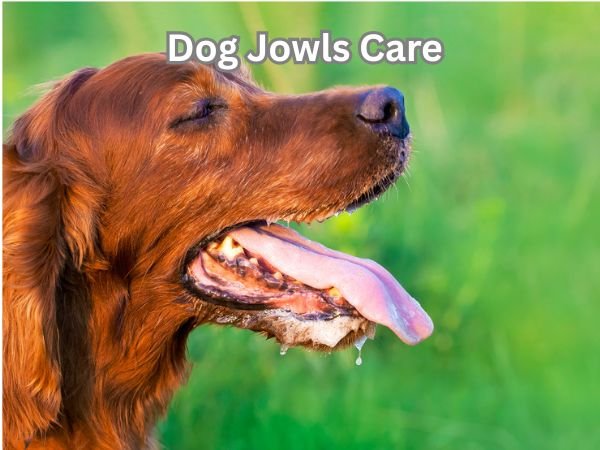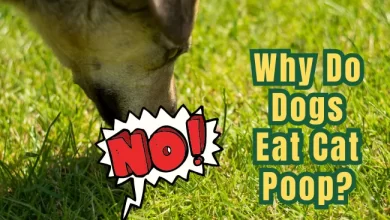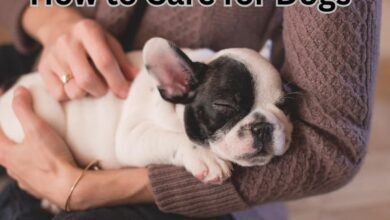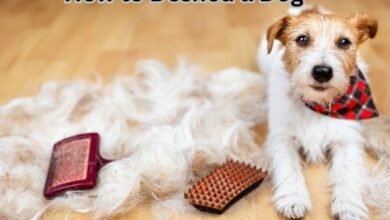
Dog jowls are the loose folds of skin that hang around a dog’s mouth, especially prominent in breeds like Bulldogs and Bloodhounds. These unique skin folds not only give dogs their charming, expressive faces but also serve important functions such as protecting the mouth, aiding in moisture retention, and helping with scent collection. Because of their shape and position, dog jowls naturally trap moisture, food particles, and bacteria, which makes them prone to infections if not cared for properly. This is why dog jowls care is essential for your pet’s health and comfort. However, many dog owners unknowingly make mistakes in caring for their dog’s jowls, which can lead to irritation, infections, and discomfort.
In this article, we will explore seven shocking mistakes owners often make and share practical tips to keep your dog’s jowls healthy and clean, helping you provide the best care possible.
What Are Dog Jowls and Why Do They Need Special Care?
If you’re a dog owner, you may have noticed those loose, floppy lips and skin hanging from your pup’s lower jaw—these are dog jowls. While all breeds have some form of jowls, you’ll see them in full glory on dogs like Bloodhounds, Mastiffs, and Bulldogs. But what exactly are jowls, and why should you pay special attention to them?
Anatomy and Function of Dog Jowls
Dog jowls are the thick folds of skin, muscle, and connective tissue on both sides of a dog’s mouth, especially around the lower jaw.
- Protection: Jowls cover teeth and gums, shielding them during play or while chewing on bones.
- Moisture Control: They help keep the mouth moist, which aids in swallowing and tasting food.
- Expression: Those droopy lips add tons of personality, but they also help with quirky doggie facial expressions.
- Scent Detection: In scent hounds, large jowls trap smells, making these breeds world-class sniffers!
Common Issues with Dog Jowls
While jowls are cute and full of character, they can also lead to some messy (and sometimes smelly) problems:
- Drooling: Some dogs have extra drooly jowls. It’s not just about the “slobber factor”—constant moisture can lead to skin problems.
- Dog Jowl Infections: Warm, damp areas in the jowl folds give bacteria a perfect place to grow. Look for signs like redness, swelling, or a bad smell.
- Irritation: Jowls can become irritated due to leftover food, dirt, or even from your dog’s own saliva.
Why Special Care Is Important
Neglecting your dog’s jowls can lead to discomfort and health issues. Here’s how to keep your furry friend’s jowls in tip-top shape:
Actionable Tips for Dog Skin Folds Care
- Daily Wipe-Down: Use a soft, damp cloth or dog-specific wipes to gently clean around the jowls after meals or playtime.
- Check for Redness or Odor: Regularly inspect your dog’s jowls for any signs of infection or irritation.
- Dry Thoroughly: After cleaning, make sure the skin folds are dry to prevent bacteria and yeast from taking hold.
- Trim Nearby Hair: Keeping the hair around the jowls short helps reduce trapped dirt and moisture.
- Monitor Drool: If your dog suddenly starts drooling more than usual or the drool smells bad, it’s time to see the vet.
Emotional Connection: Making Jowl Care a Bonding Moment
Caring for your dog’s jowls isn’t just about health—it’s a sweet opportunity to bond. Many dogs love the gentle attention and will happily sit while you clean their jowls. Make it a soothing routine, offering treats and plenty of praise.
Dog jowls are more than a droopy detail—they’re a lovable part of your furry companion’s charm and unique needs. With a little daily care and attention, you’ll keep those jowls healthy, clean, and kissable for years to come.
Mistake #1: Ignoring Regular Cleaning of Dog Jowls
When it comes to caring for your dog, one area often overlooked is the jowls. These loose folds of skin around your dog’s mouth can trap dirt, moisture, and food particles. If left uncleaned, they can become a hotspot for bacteria, causing unpleasant odors and even infections. Let’s talk about why cleaning dog jowls is so important and how you can keep them healthy with simple daily care.
Why Regular Cleaning of Dog Jowls Matters
Dog jowl hygiene is more than just a grooming task—it’s essential for your dog’s comfort and health. Here’s why:
- Bacteria buildup: The warm, moist environment in jowls creates a perfect place for bacteria to grow.
- Bad smells: Leftover food and moisture can lead to a smelly mouth area.
- Infections: Without cleaning, your dog can develop painful infections or skin irritations.
- Discomfort: Dirty jowls can make your dog uncomfortable and may lead to excessive scratching or rubbing.
How to Clean Dog Jowls Properly
Keeping your dog’s jowls clean doesn’t have to be difficult. Try these simple tips:
- Use a damp cloth or pet-safe wipe: Gently wipe inside the folds to remove debris and moisture.
- Check daily, especially after eating or outdoor play: This helps catch buildup before it causes problems.
- Dry the area well: Moisture left in folds can lead to infections, so make sure to dry thoroughly.
- Look for signs of irritation: Redness, swelling, or a bad smell may mean an infection. Consult your vet if you notice any of these.
Making Jowl Cleaning Part of Your Routine
Many pet owners find that incorporating jowl care into their daily routine builds a great habit:
- Clean jowls right after mealtime.
- Use positive reinforcement, like treats or praise, to make the experience pleasant.
- Keep your cleaning tools handy in a spot you remember.
By paying attention to your dog’s jowls and sticking to regular cleaning, you help prevent discomfort and health issues. Your dog will thank you with a happy, fresh, and healthy smile!
Mistake #2: Using Harsh or Inappropriate Cleaning Products
When it comes to caring for your dog’s jowls, one of the easiest mistakes to make is reaching for the wrong cleaning products. While it may seem convenient to use whatever you have at home, many human cleaners are far too harsh for your pet’s sensitive skin.
Why Human Cleaners Are a No-Go
Human soaps, sanitizers, and even baby wipes can cause irritation, dryness, or allergic reactions around your dog’s jowls. Dogs’ skin is more delicate than ours, and harsh chemicals can do more harm than good.
Relatable example: Imagine having chapped lips and using a strong household cleaner on them—that’s how uncomfortable it can feel for your pup!
How to Choose Safe Dog Jowl Cleaning Solutions
To keep your dog comfortable and healthy, stick with products made just for dogs or those recommended by your vet. Here are some dog-friendly tips:
- Use vet-approved cleaning solutions that are specially designed for dogs.
- Try dog-specific wipes or gentle, fragrance-free cleansers labeled as safe for pets.
- If in doubt, ask your veterinarian for a brand they trust for safe dog jowl cleaning.
Dog-Friendly Cleaning Products: What to Look For
Check the label or product information for the following:
- Alcohol-free and fragrance-free ingredients
- Products that mention dog-safe or vet-approved
- No harsh chemicals like bleach, ammonia, or strong detergents
Quick Tips for Happy, Clean Jowls
- Clean your dog’s jowls regularly but gently.
- Use a soft cloth or cotton pad with dog-friendly cleaning products.
- After cleaning, reward your pup with a treat or some cuddles—make it a positive experience!
Caring for your dog’s jowls can prevent discomfort and health problems. With the right, safe products and a gentle touch, your furry friend’s face will stay clean, comfy, and kissable!
Mistake #3: Overlooking Signs of Infection or Inflammation
Taking care of your dog’s jowls isn’t just about keeping them looking good—it’s also about protecting your pup’s health. One of the most common mistakes pet owners make is missing early signs of infection or inflammation in the jowls and facial folds. Let’s explore what you should watch for and how to help your furry friend stay happy and healthy.
Signs Your Dog’s Jowls May Be Infected
Paying close attention to your dog’s cheeks and mouth area can help you spot problems before they get worse. Here are common dog jowl infection symptoms and facial fold infection signs:
- Redness: The skin looks pinker or redder than usual.
- Swelling: Puffiness, bumps, or changes in size.
- Discharge: Any oozing fluid or pus, sometimes seen as crusts around the mouth.
- Bad Smell: A strong, unpleasant odor you notice when near your dog’s face, even after cleaning.
If you notice any of these symptoms, don’t brush it off. These could point to an infection brewing in your dog’s sensitive facial folds or jowls.
When to Call the Vet
If your dog has any of the signs above, especially if they last more than a day or get worse, it’s time for a vet visit. Acting quickly helps your pup recover faster and keeps small problems from turning into big ones. Remember:
- Dogs can’t tell us when they hurt, so it’s up to us to watch for warning signs.
- Early treatment can prevent discomfort and complications.
Keeping Your Dog Comfortable
Preventing dog jowl infections is all about regular care:
- Clean your dog’s jowls and facial folds gently every day, especially after meals or outdoor play.
- Use a soft cloth or pet-safe wipes.
- Watch for changes in appearance, texture, or smell during your daily routine.
Regular jowl checks can keep your dog tail-wagging and healthy. Trust your instincts—if something seems off, your vet is just a phone call away. By staying alert to changes and acting fast, you help your pet avoid discomfort and enjoy life to the fullest!
Mistake #4: Neglecting Regular Grooming Around the Jowls
When it comes to caring for your dog’s jowls, skipping regular grooming can cause more trouble than you might think. The area around the jowls is a common spot for mats and moisture buildup, which can lead to discomfort and even skin problems. Let’s talk about why grooming this tricky area matters and how you can do it right.
Why Groom Around the Jowls?
Your dog’s jowls have loose skin and often longer hair, especially in breeds like Bulldogs or Spaniels. This creates perfect little nooks where dirt, food, and moisture can get trapped. Without regular attention, the hair can tangle and form mats. Mats not only look messy but can pull on your dog’s skin, causing pain or irritation. Moisture trapped under mats can also lead to infections or bad smells.
How Grooming Helps
- Prevents Mats: Brushing the hair around the jowls helps keep it smooth and free of tangles.
- Reduces Moisture: Trimming excess hair lets air circulate, keeping the skin dry.
- Keeps Your Dog Comfortable: Clean, well-groomed jowls cut down on itching and irritation.
- Helps Spot Problems Early: Regular grooming gives you a chance to check for redness, swelling, or signs of infection.
Grooming Tools and Techniques for Dog Jowls Care
To care for your dog’s jowls properly, here are some tools and tips to keep in mind:
- Soft-Bristle Brush or Comb: Choose a gentle brush or wide-tooth comb to ease through hair without pulling.
- Grooming Scissors: Use rounded-tip scissors to carefully trim hair around the jowls. Be extra cautious—this is a sensitive area.
- Cleaning Wipes: Occasionally wipe the jowls with pet-friendly grooming wipes to remove dirt and moisture.
- Regular Schedule: Aim to check and groom this area 2-3 times per week, or more often if your dog spends a lot of time outdoors or has long hair.
- Be Gentle and Patient: Take your time and speak softly to keep your dog calm during grooming.
A Little Effort Goes a Long Way
Think of jowl grooming as a small but valuable part of your dog’s overall care. You’re not just keeping them looking good—you’re helping prevent discomfort and health issues. Plus, these moments can strengthen your bond, showing your dog that grooming is a moment of love and attention.
If you notice any unusual redness, swelling, or a persistent smell even after grooming, it’s wise to ask your vet for advice. But with regular brushing, trimming, and gentle cleaning, you’ll keep your dog’s jowls healthy and happy.
Mistake #5: Feeding Habits That Contribute to Jowl Issues
Every dog owner wants their furry friend to feel comfortable and healthy, but sometimes we overlook small habits that can lead to bigger problems—especially when it comes to those adorable, droopy jowls. Let’s talk about why feeding routines matter for your dog’s jowl hygiene and how you can help keep their face fresh and rash-free.
How Messy Meals Make Things Worse
- Messy or wet foods easily cling to your dog’s jowls.
- Jowls trap leftover bits, saliva, and moisture—creating a perfect spot for bacteria to grow.
- Over time, this can lead to redness, irritation, and the dreaded drool rash.
If your dog eats canned food, soaked kibble, or anything sticky, you’ve probably noticed bits of food sticking to the skin around their mouth. These tasty leftovers may be a feast for germs, too!
Smart Feeding Habits for Cleaner Jowls
You can help prevent jowl problems by changing how and what your dog eats:
- Switch to Dry Kibble: Dry food is less likely to stick to jowls than wet or mushy meals.
- Use Elevated Feeders: Raising your dog’s bowl can help keep their head up, making mealtimes less messy.
- Wipe After Every Meal: Gently clean your dog’s mouth and jowls after eating with a soft, damp cloth.
- Routine Checks: Peek under those folds daily to spot any food bits, moisture, or redness early on.
Dog Feeding Hygiene: Why It Matters
Practicing good “dog feeding hygiene” is an easy way to protect your pup’s health:
- Clean bowls daily—old food builds up bacteria!
- Wash your hands before and after handling your dog’s food.
Preventing Drool Rash
Some dogs naturally drool more than others, but you can minimize rash risk:
- Keep the jowls dry and clean, especially after meals or playtime.
- Apply a vet-recommended ointment if you notice any irritated spots.
- Regular grooming helps, too—long hair around the mouth tends to trap drool and crumbs.
Caring for your dog’s jowls might seem like a small task, but these simple steps go a long way. By keeping mealtime tidy and sticking to a cleaning routine, you’ll help your best friend avoid discomfort and keep those lovable jowls happy and healthy!
Mistake #6: Not Managing Excessive Drooling Properly
Has your furry friend turned your home into a drool zone? You’re not alone! Many dogs—especially those with big, lovable jowls—tend to drool a lot. While a little slobber can be cute, too much can be messy and even uncomfortable for your dog.
Top Tips for Managing Dog Drool
- Keep Wipes Handy: Gently wipe your dog’s jowls with a soft cloth or pet-friendly wipes several times a day. This helps prevent saliva from irritating their skin or making your furniture sticky.
- Have a Drool Towel: Keep a dedicated towel near areas where your dog likes to relax. Wipe their mouth after meals, playtime, or drinks of water.
- Check for Food Traps: Sometimes food or treats get stuck in those floppy folds, which can make drooling worse. Gently inspect and clean out any gunk after eating.
- Stay on Top of Grooming: Trim excess hair around the mouth to prevent it from collecting saliva or debris.
- Change Bedding Frequently: Wash your dog’s bedding and toys often so the drool doesn’t build up and create odors.
Drooly Dog Breeds: Who Drools the Most?
Some breeds are famous for their charmingly soggy smiles. If you have one of these puppers, a little extra care goes a long way:
- Saint Bernards
- Newfoundlands
- Bloodhounds
- Bulldogs
- Mastiffs
- Great Danes
These breeds have big, loose jowls and skin folds that catch and pool saliva—meaning more drool for you to manage!
Special Care Tips for Drooly Dog Breeds
- Skin Checks: Those sweet jowls can hide moisture, leading to skin irritation or infections. Examine and dry skin folds daily to keep them healthy.
- Hydration Station: Place a washable mat under your dog’s water bowl to catch splashes and drips.
- Regular Vet Visits: Sometimes, excessive drooling is a sign of dental issues or other health problems. If you notice sudden changes, check in with your vet.
Connecting With Your Drooly Dog
Living with a drooly dog can be a challenge, but remember: those slobbery kisses mean you’re loved! With regular care and a splash of patience, you’ll both stay happy—and a little less sticky.
Mistake #7 – Delaying Veterinary Care and Checkups
If your dog has those adorable, droopy jowls or skin folds, you already know they add to their charm. But did you know these folds need special attention? One common mistake many pet owners make is putting off regular vet visits for these areas. Let’s talk about why timely veterinary care is key to keeping your dog comfortable and healthy.
Why Regular Vet Checkups Matter for Dogs with Jowls
Dogs with skin folds and jowls are more prone to certain health issues that can be easy to miss until they become serious. What looks like simple drool stains or redness might signal deeper problems like infections or irritation.
A vet’s expert eye can catch:
- Skin fold infections: These can cause redness, bad odor, and discomfort.
- Underlying allergies or irritants: Your dog might be reacting to something in their environment.
- Early signs of dental or oral issues: Since jowls are close to the mouth, vets can check for problems like gum disease.
By delaying checkups, small problems can get worse, potentially leading to pain, costly treatments, or long recovery times.
What You Can Do at Home
To support your dog’s jowl health between vet visits:
- Clean your dog’s skin folds daily with a damp cloth or vet-recommended wipes.
- Keep the area dry and free from debris.
- Watch for any signs like redness, swelling, bad smell, or your dog scratching and rubbing.
- Schedule regular veterinary visits, even if your dog seems fine.
When to See Your Vet
If you notice any of the following, it’s time to call your vet immediately:
- Persistent redness or swelling
- Unpleasant odor from the jowl area
- Your dog is constantly scratching or shaking its head
- Discharge or sores on or around the skin folds
Timely professional care can stop infections before they take hold.
Partnering with Your Vet for the Best Jowl Care
Good dog vet care for jowls isn’t just about emergency visits—it’s about prevention. Your vet can offer personalized advice, recommend safe cleaning products, and spot hidden problems during routine checkups.
Regular vet visits help ensure your furry friend stays happy, healthy, and comfortable. Remember, those jowls may be cute, but they need your care and your vet’s expertise, too!
Taking care of your dog’s jowls shows how much you love them. With just a little attention and timely vet visits, you can keep your pet’s unique features looking good and feeling great.
Conclusion
Proper care of your dog’s jowls is essential to keeping your pup comfortable and healthy. By taking simple, regular steps, you can prevent common issues and ensure your dog’s face stays fresh and clean. Remember, avoiding mistakes like neglect or using the wrong cleaning products makes a big difference. If you ever have concerns, don’t hesitate to check with your vet.
If you found this helpful, please share it with fellow pet lovers! And for personalized advice, always reach out to a vet who can guide you. Your dog’s health is worth every little effort.
FAQ
How often should I clean my dog’s jowls?
Clean your dog’s jowls 2–3 times a week, or daily if they drool a lot. Regular cleaning helps remove trapped food and bacteria. Use a soft cloth and dog-safe wipes to keep the area clean and dry.
What are signs of infection in dog jowls?
Watch for redness, swelling, bad smell, pus, or your dog scratching or rubbing its face. These signs may mean infection. If you see them, call your vet for help as soon as possible.
Can I use baby wipes on my dog’s jowls?
It’s best to avoid baby wipes. Many contain ingredients that may irritate a dog’s skin. Use dog-safe wipes made for pets, especially for sensitive areas like the jowls.
Why do my dog’s jowls smell bad?
Bad smell in dog jowls usually means trapped food, drool, or a possible infection. Bacteria and yeast grow in moist folds. Cleaning your dog’s jowls often can stop the smell and keep the area healthy.
What’s the best cleaner for dog jowls?
Use pet-safe wipes, diluted chlorhexidine, or a vet-approved cleanser. Avoid harsh soaps or alcohol. Always dry the jowls after cleaning to stop bacteria from growing in the folds.



